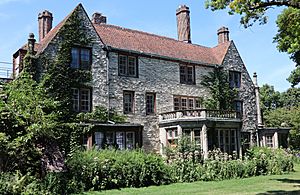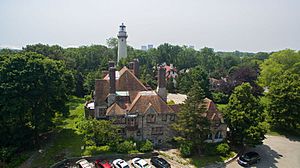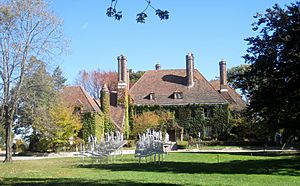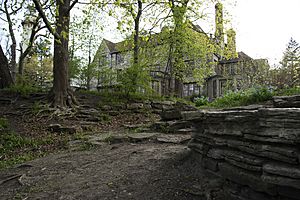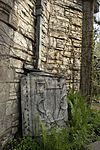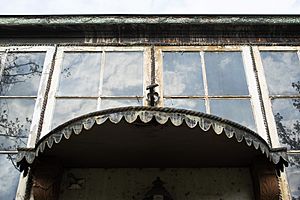Harley Clarke Mansion facts for kids
The Harley Clarke Mansion is a beautiful house and coach house in Evanston, Illinois. It's built in a French Eclectic style, which means it mixes different French architectural ideas. The mansion is right next to the historic Grosse Pointe Lighthouse and Lighthouse Beach on Lake Michigan.
This mansion is an important part of the Northeast Evanston Historic District, which was created in 1999. It's also listed on the National Register of Historic Places, meaning it's officially recognized as a special historic building. In 2016, a group called Landmarks Illinois added the Harley Clarke Mansion to its list of most endangered historic places in Illinois. This means they believe it's at risk and needs to be saved.
Contents
History of the Mansion
The Harley Clarke Mansion was finished in 1927. It was designed by architect Richard Powers for Harley Clarke, his wife Hildur, and their two children. Harley Clarke was a very rich businessman who owned many light, power, and gas companies. He was also involved in Chicago's high society and later became the president of Fox Film, a big movie company. His wealth was once estimated to be over $60 million!
Mansion Design and Features
The mansion has three stories and 16 rooms. It's made of limestone and was originally built on almost five acres of land by the lake. The outdoor areas were designed by famous landscape architects Jens Jensen and Alfred Caldwell. Jensen was known for his "Indian Council Rings," which are special circular gathering places, and one of these was part of the mansion's original design.
Even though the landscape has changed over time, some original features are still there. These include a pond with a waterfall, a council ring, and many paths and terraces.
The mansion is huge, about 18,500 square feet! It has seven bedrooms, a large glass conservatory (like a sunroom), a ballroom, and a coach house. It also has six tall chimneys and a beautiful curving staircase inside.
The house was inspired by English Tudor country homes from the 1500s. Its red tile roof looks a bit like Norman style. The walls are made of rough-cut ashlar stone, giving it a Cotswold look, with carved limestone and red sandstone decorations. The chimneys are very tall and stand out above the roof.
The main part of the house faces north and south, running parallel to the lake. The service wing, which was for staff, is on the north side and has a lower roof.
The main entrance has a large flower statue above it. Outside, decorative lead rain gutter downspouts lead into fancy metal cisterns. Inside, the main entrance hall is a beautiful oval room with wood panels, a curving staircase, and a fireplace. From this hall, you can see Lake Michigan through the tall windows of the sun porch.
Many of the main rooms on the ground floor are connected and face the lake, offering great views. The dining room fireplace is at one end, and a door to the conservatory is at the other, giving a view of green plants all year round.
At the south end of the mansion is a large conservatory with a glass roof and stone walls. It has covered entrances on both sides, decorated with stone pillars and flower statues, similar to the main entrance. Next to the conservatory is a large coach house, built in the same style as the main mansion.
When the house was finished, it won a design award from the Evanston Art Commission. It was the last house of its size built in Evanston before the Great Depression hit.
Changes in Ownership
The Clarke family owned the house until 1949. They had to sell it because they lost a lot of money during the Great Depression.
From 1951 to 1965, a college fraternity called Sigma Chi used the mansion as its main office. Then, the city of Evanston bought it. A year later, the Evanston Art Center rented the property and used it until 2015. The mansion needed a lot of repairs, and neither the city nor the art center could afford them.
Since 2015, the Harley Clarke Mansion has been empty. A report in 2016 said the mansion was mostly in good shape but still needed money for repairs. When the Evanston Art Center was there, the main floor rooms became art galleries. The bedrooms upstairs and the ballroom on the third floor were used as classrooms. The basement even had a pottery studio with kilns and pottery wheels!
Why the Mansion is Important
The Harley Clarke Mansion is very special for its architecture and its history in Evanston.
In 1928, it won a design award from the Evanston Art Commission. In 1982, it was officially named an Evanston landmark.
Experts have called the mansion "a striking architectural presence." Stuart Cohen and Susan Benjamin, who wrote a book about houses in the area, said it was the last house of its size built in Evanston before the 1929 stock market crash.
Bonnie McDonald, who leads Landmarks Illinois, compared Jens Jensen, the landscape architect, to Frank Lloyd Wright because he was so important in designing natural landscapes. She thinks it's strange that the city would consider tearing down its own landmark.
Another book, "Evanston: 150 Years, 150 Places," describes the mansion as "one of Evanston's most picturesque mansions." It also mentions how the rooms were designed to offer views all the way through the house, so you could see Lake Michigan right from the front door!
In 2017, the Harley Clarke Mansion was even featured on the Bob Vila website as one of "15 100-Year-Old Houses That Haven't Aged a Day." The article said the mansion has always kept its "original elegance or intrigue" and that Evanston decided to open its historic doors to the public again.
Plans for the Lakefront
In 2008, the Evanston City Council approved the Lakefront Master Plan. This plan is like a guide for future projects along Evanston’s lakefront.
The plan suggested that the Harley Clarke Mansion, which was home to the Evanston Art Center at the time, should be fully restored. The plan emphasized keeping the historic nature of the buildings and the Jens Jensen landscape. It also suggested new activities to help pay for the restoration.
For example, the plan proposed using the mansion's beautiful grounds for public events like weddings. It also suggested turning the coach house into a café or gift shop to bring more visitors and support local artists. These ideas were meant to help fund the mansion's restoration and upkeep.
Efforts to Save the Mansion
Over the years, there have been many discussions about what to do with the Harley Clarke Mansion.
Private Offers
In 2013, a company offered to buy the mansion and turn it into a hotel. However, the city council said no because many people didn't want public land to become private.
Public Use Ideas
In 2013, the Illinois Department of Natural Resources talked about buying the mansion to use as an office and a public education center about the coast. But this plan didn't work out, partly because of a new governor and state budget problems.
Preservation vs. Demolition
In 2017, the city asked non-profit groups to propose ideas for leasing and managing the mansion. One group, Evanston Lakehouse & Gardens (ELHG), suggested renovating it into a place for environmental education, community events, and cultural programs. The city council initially approved this idea.
However, in 2018, after months of talks, the city council voted against ELHG's plan. They were worried about how long it would take to get money and the city's responsibility. Later that year, the city council considered a different idea from a group called Evanston Lighthouse Dunes. This group offered to pay to tear down the mansion and restore the natural dunes and beach instead.
This idea of tearing down the mansion caused a lot of debate. Blair Kamin, an architecture critic for the Chicago Tribune, wrote that it was strange for a city known for protecting historic buildings to consider destroying a landmark. He said the mansion is a "precious, irreplaceable architectural and cultural resource" and should be saved.
A volunteer group called Save Harley Clarke quickly gathered signatures to put the issue on the November 2018 ballot. Voters were asked: "Shall the City of Evanston protect from demolition and preserve the landmark Harley Clarke buildings and gardens next to Lighthouse Beach, for use and access as public property, consistent with the Evanston Lakefront Master Plan, at minimal or no cost to Evanston taxpayers?"
On November 6, 2018, Evanston voters overwhelmingly voted to save the mansion from demolition, with over 80% saying "yes"! Some areas even had 95% support for saving it.
Despite the public vote, the city council still sent the demolition question to the Evanston Preservation Commission. On October 23, 2018, the commission voted 10-0 to deny the city's request to tear down the mansion. The city manager said he would appeal this decision to the city council, which has the power to overrule the commission.
Ken Itle, co-chair of the preservation commission, explained his vote against demolition: "I have seen nothing presented to justify the demolition of this building.... It's very clear that it's a significant building, it's a significant piece of architecture, it's a unique design and it would be a great loss to the city if it were demolished."
Images for kids


